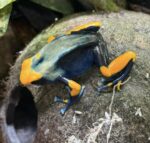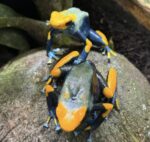Description
The dyeing poison dart frog (Dendrobates tinctorius Peacock), also known as the cobalt poison frog, tinc (a nickname given by those in the hobby of keeping dart frogs), is a species of poison dart frog. It is among the most variably colored and largest species of poison dart frogs, typically reaching snout–vent lengths of about 50 mm (2.0 in). It is distributed in the eastern portion of the Guiana Shield, including parts of French Guiana, Guyana, Suriname, and Brazil.
These types of frogs usually like to stay in the ground as it is easier to catch prey. They tend to also stay in bodies of water like rivers or climb trees. Because of this they mostly inhabit near the Amazon Rainforest. To mate they have special rituals and leave their tadpoles in freshwater.
Etymology of Dendrobates Tinctorius Peacock
The specific name, tinctorius, comes, however, not from the variety of colors, but from the legends of some indigenous tribes. It has been said that tribe members used the frog poisons to cause green parrot feathers to grow different colors.
Distribution and habitat of Dendrobates Tinctorius Peacock
The dyeing poison dart frog exists in discrete patches of the eastern Guiana Shield, being found at altitudes up to 600 m (2,000 ft).
It is found in regions of tropical primary rainforests, but is associated with areas with canopy gaps. While this species can be found at sea level, it is mostly found in upland areas, for example in hills or at the base of mountains.
The isolation of populations has presumably occurred as a result of the erosion of these highlands and the seasonal inundation of the inter-patch areas. A study shows that Dendrobates tinctorius tadpoles can survive in pools having a high level of KH, vertical height of 15 mi (79,000 ft) and salinity up to 955 ppm.
Description of Dendrobates Tinctorius Peacock

The dyeing poison dart frog is large for a poison dart frog, but may be smaller than Phyllobates terribilis and Ameerega trivittata. Small forms of D. tinctorius reach 3.5 cm (1.4 in) in snout–vent length; most variants are around 5 cm (2.0 in) in length or slightly bigger; some of the largest variants may reach 7 cm (2.8 in).
Although some variants are smaller or larger, differences tend to be average with some overlap in full size range (i.e., a large individual of a small variant often is comparable in size to a small individual of a large variant).























Reviews
There are no reviews yet.